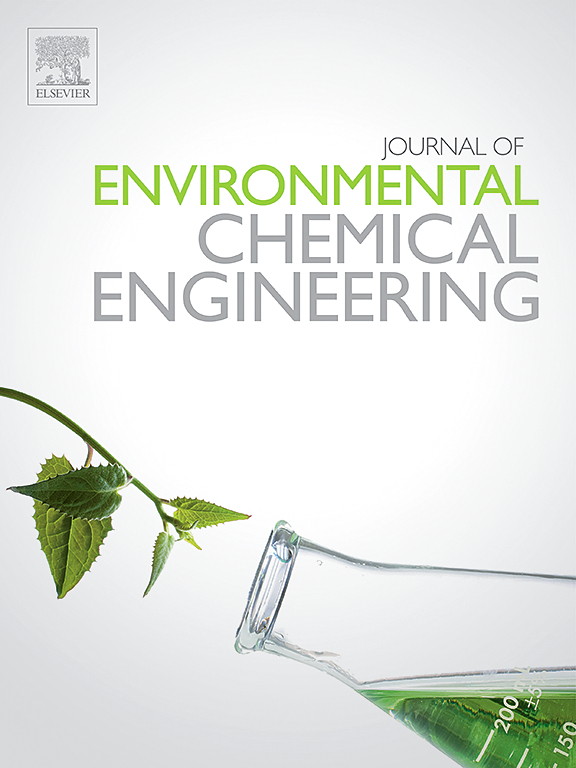超声空化与深度氧化的协同作用机理:工业废水的自由基路径优化与深度处理
IF 7.4
2区 工程技术
Q1 ENGINEERING, CHEMICAL
引用次数: 0
摘要
在工业废水中,多环芳烃(PAHs)、全氟化合物(PFAC)和药物残留等具有环境持久性、生物蓄积性和生态毒性的新兴污染物对生态安全和人类健康构成严重威胁。高级氧化技术(AOPs)通过自由基氧化反应实现有机物的深部矿化,已成为污水处理的核心手段。然而,单一AOPs的应用受到传质效率低、催化剂失活、副产物产生和能耗高等瓶颈的限制。超声波技术突破了传统技术的局限,通过物理化学的协同作用机制,通过增强传质、激活氧化剂和催化剂再生,显著提高了AOPs的效率。本文首先综述了单一AOPs的研究现状及局限性。然后,以超声氧化技术为切入点,系统探索超声协同先进氧化技术(US-AOPs)的跨尺度协同机理和工业应用潜力。揭示了超声空化效应与Fenton、臭氧、电化学、光催化等技术的耦合协同途径及其调控副产物生成的机理。其次,通过工业案例论证了US-AOPs在工业化过程中的经济性和稳定性。从成本、可扩展性和操作稳健性方面分析了us - apo面临的挑战。研究发现,跨学科新兴技术的融合有望推动US-AOPs污水处理向高效、低碳、智能化方向转变,为工业废水近零排放和资源化利用提供创新解决方案。本文章由计算机程序翻译,如有差异,请以英文原文为准。
Synergistic mechanism of ultrasonic cavitation and advanced oxidation: Free radical path optimization and advanced treatment of industrial wastewater
In industrial wastewater, emerging pollutants with environmental persistence, bioaccumulation and ecological toxicity (polycyclic aromatic hydrocarbons (PAHs), perfluorinated compounds (PFAC) and drug residues) pose a serious threat to ecological security and human health. Advanced oxidation technologies (AOPs) have become the core means of wastewater treatment by achieving deep mineralization of organic matter through free radical-mediated oxidation reactions. However, the application of single AOPs is limited by bottlenecks such as low mass transfer efficiency, catalyst deactivation, by-product generation and high energy consumption. Ultrasound technology significantly improves the efficiency of AOPs by enhancing mass transfer, activating oxidants and catalyst regeneration through a synergistic physicochemical mechanism that breaks through the limitations of conventional technologies. This review firstly summarizes the current research status and limitations of single AOPs. Then, ultrasonic oxidation technology seen as an entry point, it systematically explores the cross-scale synergistic mechanism and industrial application potential of ultrasonic synergistic advanced oxidation technologies (US-AOPs). This reveals the coupled synergistic pathways of ultrasonic cavitation effect with Fenton, ozone, electrochemical and photocatalytic technologies and the mechanism of regulating the generation of by-products. Secondly, the economics and stability of US-AOPs in industrialization are demonstrated through industrial cases. The challenges faced by US-APOs are analysed in terms of cost, scalability, and operational robustness. It is found that the integration of interdisciplinary emerging technologies is expected to promote the transformation of wastewater treatment in US-AOPs towards a high efficiency, low carbon and intelligent, which provides innovative solutions for near-zero discharge and resource utilisation of industrial wastewater.
求助全文
通过发布文献求助,成功后即可免费获取论文全文。
去求助
来源期刊

Journal of Environmental Chemical Engineering
Environmental Science-Pollution
CiteScore
11.40
自引率
6.50%
发文量
2017
审稿时长
27 days
期刊介绍:
The Journal of Environmental Chemical Engineering (JECE) serves as a platform for the dissemination of original and innovative research focusing on the advancement of environmentally-friendly, sustainable technologies. JECE emphasizes the transition towards a carbon-neutral circular economy and a self-sufficient bio-based economy. Topics covered include soil, water, wastewater, and air decontamination; pollution monitoring, prevention, and control; advanced analytics, sensors, impact and risk assessment methodologies in environmental chemical engineering; resource recovery (water, nutrients, materials, energy); industrial ecology; valorization of waste streams; waste management (including e-waste); climate-water-energy-food nexus; novel materials for environmental, chemical, and energy applications; sustainability and environmental safety; water digitalization, water data science, and machine learning; process integration and intensification; recent developments in green chemistry for synthesis, catalysis, and energy; and original research on contaminants of emerging concern, persistent chemicals, and priority substances, including microplastics, nanoplastics, nanomaterials, micropollutants, antimicrobial resistance genes, and emerging pathogens (viruses, bacteria, parasites) of environmental significance.
 求助内容:
求助内容: 应助结果提醒方式:
应助结果提醒方式:


